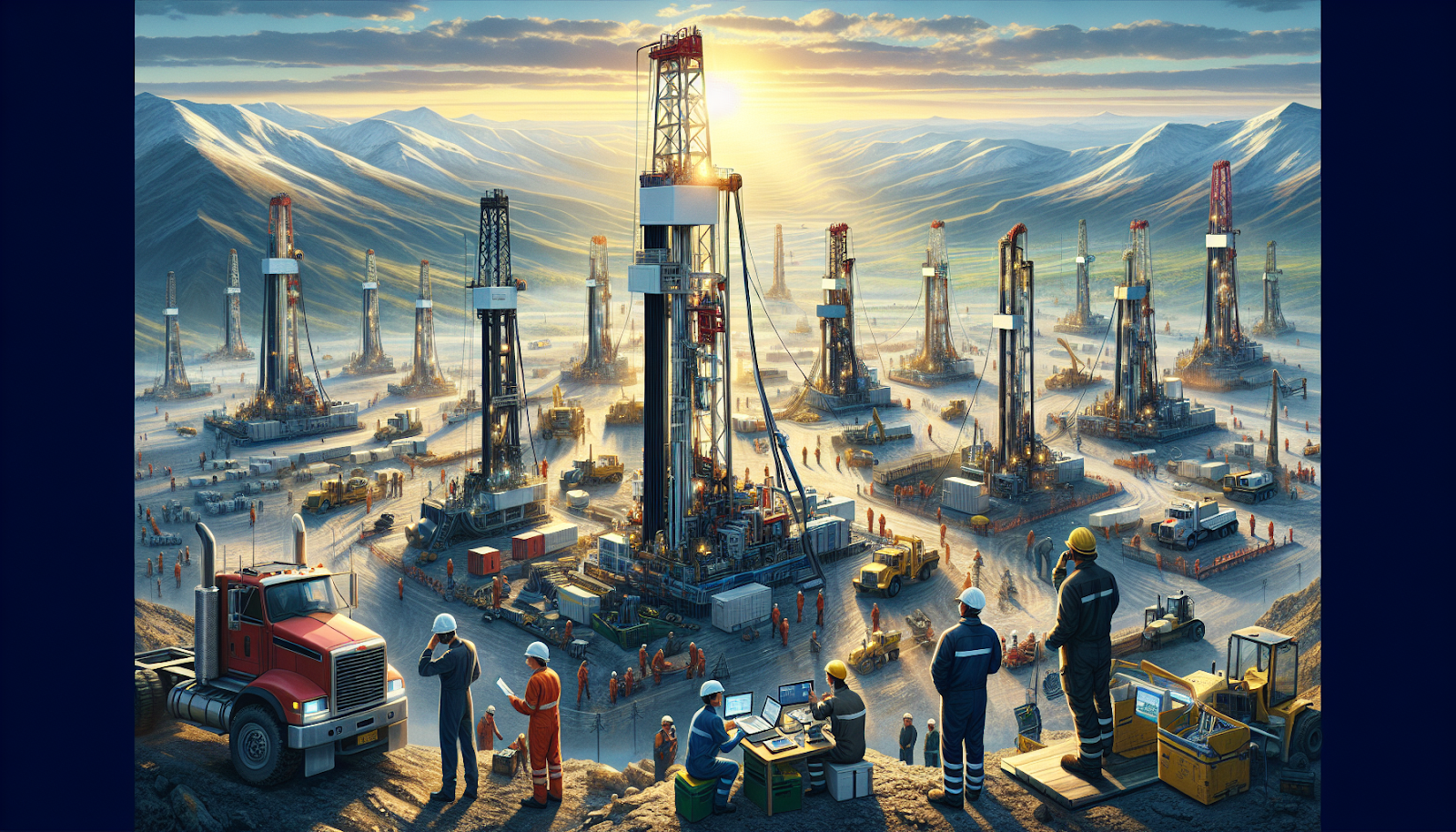Introduction to Geothermal Energy
Geothermal energy is a renewable and sustainable energy source that harnesses the heat from the Earth’s core. This heat is generated by the radioactive decay of minerals and the original formation of the planet. Geothermal energy can be used for heating, cooling, and generating electricity, making it a versatile and valuable resource.
What is Geothermal Drilling?
Geothermal drilling is the process of creating boreholes in the Earth’s crust to access geothermal resources. This process involves the use of specialised drilling rigs that can withstand high temperatures and pressures encountered at great depths. Geothermal drilling allows us to tap into the Earth’s heat and utilise it for various applications.
Types of Geothermal Drilling
There are two main types of geothermal drilling:
- Shallow drilling: This type of drilling is used for geothermal heat pumps and typically reaches depths of up to 400 feet.
- Deep drilling: Deep drilling is used for geothermal power plants and can reach depths of several kilometres.
The Geothermal Drilling Process
Site Selection and Preparation
The first step in the geothermal drilling process is to identify a suitable location for the borehole. Geologists and engineers conduct site surveys to assess the geothermal potential of an area. Once a site is selected, the area is prepared for drilling by clearing the land and setting up the necessary infrastructure.
Drilling Techniques
Geothermal drilling rigs use various techniques to create boreholes, depending on the depth and geological conditions of the site. Some common drilling techniques include:
- Rotary drilling: This method uses a rotating drill bit to crush and remove rock material.
- Percussion drilling: This technique involves the use of a hammering action to break up rock formations.
- Directional drilling: This method allows for the creation of deviated or horizontal boreholes to access geothermal resources in different locations.
Casing and Cementing
Once the borehole is drilled, steel casing is inserted to maintain the integrity of the borehole and prevent collapse. The space between the casing and the borehole wall is then filled with cement to provide additional stability and prevent fluid migration between different geological formations.
Well Completion
After the casing and cementing process, the well is completed by installing production tubing and other necessary equipment. This allows for the efficient extraction of geothermal fluids from the reservoir.
Geothermal Drilling Rigs
Components of a Geothermal Drilling Rig
A geothermal drilling rig consists of several key components, including:
- Drill string: This is the series of connected drill pipes that transmit rotary motion and drilling fluid to the drill bit.
- Drill bit: The drill bit is responsible for cutting and crushing rock formations to create the borehole.
- Mud pumps: These pumps circulate drilling fluid (mud) through the drill string and up the annulus, carrying rock cuttings to the surface.
- Blowout preventer (BOP): The BOP is a safety device that seals the wellbore to prevent the uncontrolled release of geothermal fluids.
Rig Types and Configurations
Geothermal drilling rigs come in various types and configurations, depending on the specific requirements of the project. Some common rig types include:
- Truck-mounted rigs: These rigs are mounted on trucks for easy transportation between drilling sites.
- Crawler-mounted rigs: Crawler-mounted rigs are equipped with tracks for improved mobility on rough terrain.
- Offshore rigs: These rigs are used for geothermal drilling in offshore locations and are typically mounted on floating vessels or platforms.
Benefits of Geothermal Energy
Environmental Benefits
Geothermal energy offers several environmental benefits compared to fossil fuels:
- Reduced greenhouse gas emissions: Geothermal power plants emit minimal greenhouse gases, helping to mitigate climate change.
- Minimal land use: Geothermal facilities have a small land footprint compared to other energy sources.
- No fuel transportation: Geothermal energy does not require the transportation of fuel, reducing the associated environmental impacts.
Economic Benefits
Geothermal energy also provides economic benefits, such as:
- Job creation: The geothermal industry creates jobs in various sectors, including drilling, construction, and operations.
- Energy cost stability: Geothermal energy is not subject to the price fluctuations associated with fossil fuels, providing stable energy costs.
- Local economic development: Geothermal projects can stimulate local economies by providing employment opportunities and attracting investment.
Social Benefits
The development of geothermal energy has social benefits, including:
- Energy security: Geothermal resources are domestically available, reducing dependence on foreign energy sources.
- Improved quality of life: Access to clean, reliable energy can improve living standards and overall quality of life.
- Community engagement: Geothermal projects often involve local communities, fostering a sense of ownership and participation.
Challenges and Limitations
Exploration and Resource Assessment
One of the challenges in geothermal development is the accurate assessment of geothermal resources. Exploration techniques, such as geophysical surveys and exploratory drilling, are used to identify potential geothermal reservoirs. However, these methods can be costly and time-consuming.
Drilling Risks and Costs
Geothermal drilling comes with inherent risks and high costs. Some of the challenges include:
- High temperatures and pressures: Geothermal drilling encounters extreme conditions that require specialised equipment and skilled personnel.
- Drilling failures: Borehole instability, lost circulation, and equipment failures can lead to drilling delays and increased costs.
- Environmental concerns: Geothermal drilling must be conducted in an environmentally responsible manner to minimise the impact on local ecosystems.
Reservoir Management
Effective management of geothermal reservoirs is crucial for the long-term sustainability of geothermal projects. This involves monitoring reservoir performance, controlling production rates, and implementing reinjection strategies to maintain reservoir pressure and productivity.
Advancements in Geothermal Drilling Technology
Improved Drilling Techniques
Advancements in drilling technology have led to improved efficiency and reduced costs in geothermal drilling. Some notable developments include:
- Polycrystalline diamond compact (PDC) drill bits: PDC bits offer increased durability and faster penetration rates compared to traditional roller cone bits.
- Managed pressure drilling (MPD): MPD techniques allow for better control of borehole pressure, reducing the risk of drilling failures and improving well stability.
- Automated drilling systems: Automation in drilling operations enhances precision, reduces human error, and improves overall drilling performance.
Enhanced Geothermal Systems (EGS)
Enhanced Geothermal Systems (EGS) are an emerging technology that aims to expand the potential of geothermal energy. EGS involves the creation of artificial geothermal reservoirs by fracturing hot rock formations and circulating fluid through the created fractures. This technology can enable the exploitation of geothermal resources in areas previously considered unsuitable for geothermal development.
The Future of Geothermal Drilling
Expanding Geothermal Development
As the world transitions towards cleaner energy sources, the demand for geothermal energy is expected to grow. This will drive the expansion of geothermal drilling activities worldwide, particularly in regions with high geothermal potential.
Research and Development
Continued research and development efforts are crucial for advancing geothermal drilling technology. Some areas of focus include:
- Improved exploration techniques: Developing more accurate and cost-effective methods for identifying geothermal resources.
- Advanced drilling materials: Designing materials that can withstand the harsh conditions encountered in geothermal drilling.
- Sustainable reservoir management: Developing strategies for the long-term management and optimization of geothermal reservoirs.
Collaboration and Knowledge Sharing
Fostering collaboration and knowledge sharing among geothermal industry stakeholders is essential for the growth and advancement of the sector. This can be achieved through:
- International partnerships: Establishing partnerships between countries and organisations to share best practices and expertise in geothermal drilling.
- Industry-academia collaboration: Encouraging collaboration between geothermal companies and research institutions to drive innovation and technological advancements.
- Workforce development: Investing in education and training programs to develop a skilled workforce for the geothermal drilling industry.
Conclusion
Geothermal drilling plays a vital role in harnessing the Earth’s heat for sustainable energy production. The process involves the use of specialised drilling rigs to create boreholes that access geothermal resources.



